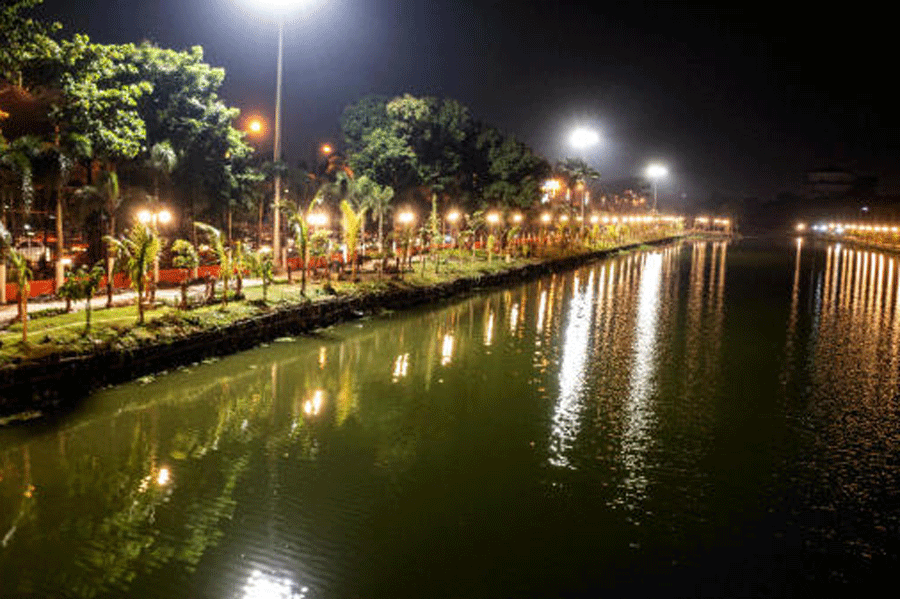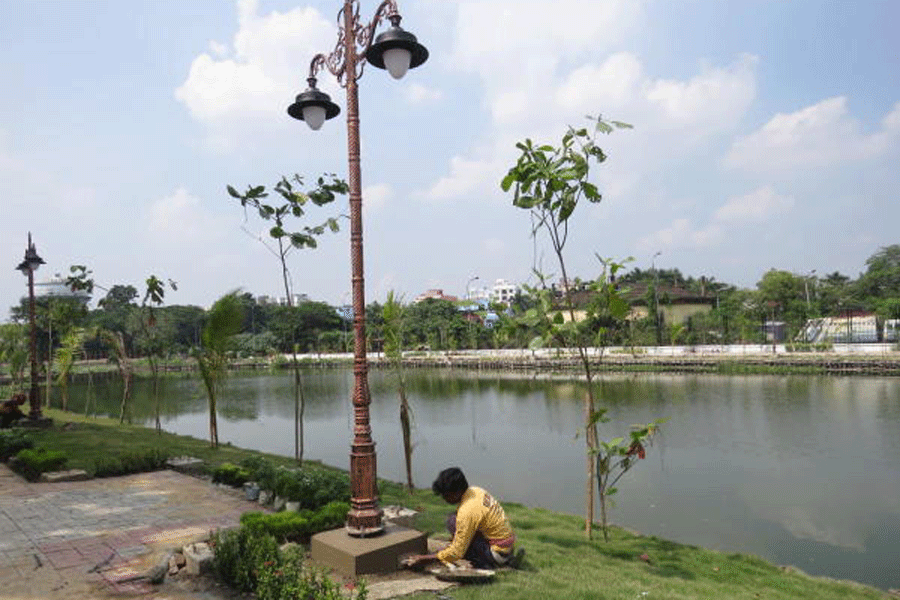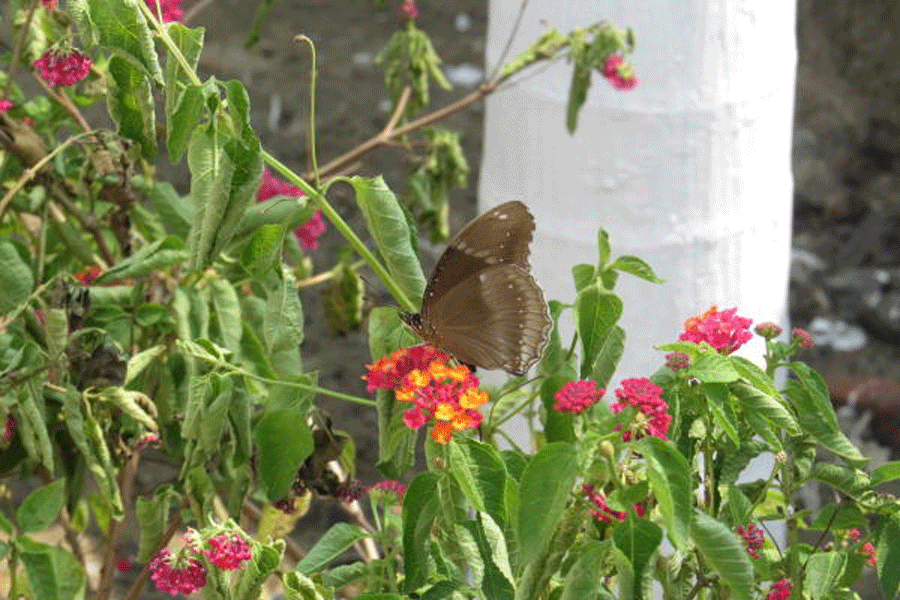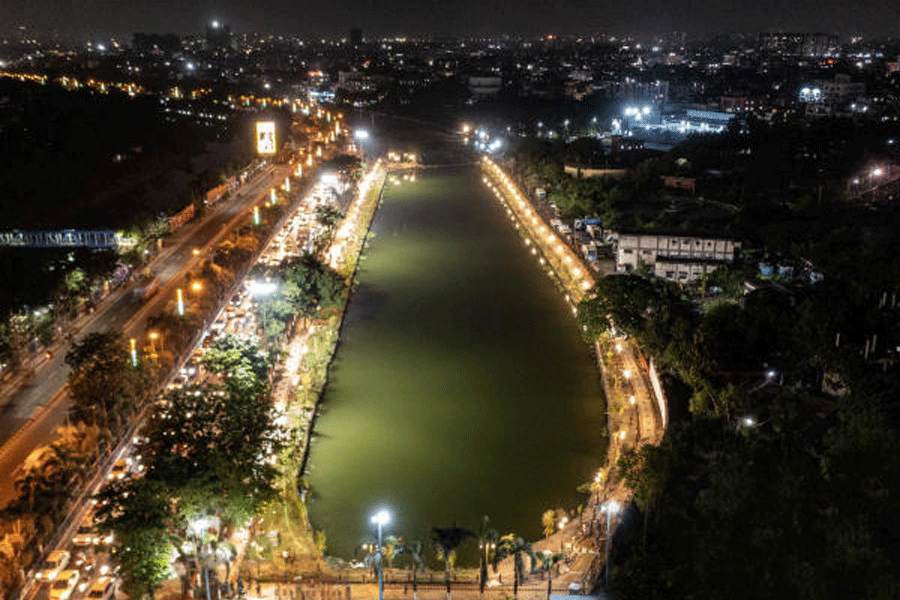A stretch by the VIP Road, that was an eyesore and a source of stench for years, will soon be a green island amid the concrete jungle that is the Dum Dum Park-Bangur Avenue-Lake Town area.
A biodiversity park is coming up there, along 600m to the left of VIP Road along the flank going towards the airport from the Ultadanga side. Local residents will soon get a landscaped area for morning walk by the burrow pit that is locally called Nayanjuli.
“About five per cent work is left,” fire and emergency services minister Sujit Bose, who is also the local MLA, told Metro on Wednesday. “We have dredged the waterbody. Walkways are being built and extensive plantation has been done. The government is spending close to Rs 10 crore on the project which is being executed by the public works department (roads),” he said.
Messy past
The waterbody was in such sorry state that during the Under-17 Fifa World Cup hosted at the Salt Lake stadium in 2017, the stretch was hidden from view by a series of tall boards publicising the state government’s welfare projects.
This was the time when was the burrow pit, excavated while constructing the higher elevated VIP Road around 1960, was the subject of litigation. A case had been filed before the National Green Tribunal pointing out how the canal was being rapidly filled up and depleted due to illegal encroachments for housing projects and uncontrolled and indiscriminate dumping of garbage and debris.

The illuminated biodiversity park. Sudeshna Banerjee
Nayanjuli, which extends from Ultadanga to Lake Town crossing on VIP Road and is situated at the northern side of Wards No. 29, 30, 34 and 35 of South Dum Dum Municipality, is one of the oldest waterbodies upon which the entire area depends.
The importance of the Nayanjuli was documented in detail before the court. Many parts of Calcutta, it was argued, suffered from Urban Heat Island effect, making them significantly warmer than their surrounding rural areas. Since the presence of wetlands prevents the formation of urban heat islands, the vast Nayanjuli could improve the local environment if plantation was carried out on its sides.
The water body with its fish and other aquatic organisms, plantations on its sides, birds etc., it was suggested, could become a reservoir of biodiversity. There were other environmental benefits cited, including nutrient re-cycling, ground water recharge, functioning as a natural carbon sink.
It could also be a source of water during fire hazards and reduce water-logging during monsoon.

Work underway at Biodiversity Park.
The applicant had argued that the waterbody was rapidly getting depleted due to encroachments by uncontrolled housing projects, urban expansion and indiscriminate dumping of garbage and waste encouraged by neglect and lack of effort on the part of the authorities for its protection and preservation.
Much of the burrow pit from Ultadanga to Lake Town had already been lost by then due to activities of unscrupulous real estate developers especially between 2004 and 2014. A joint research on the status of the Nayanjuli carried out by the state environment department and the NGO South Asian Forum for Environment had revealed that 42 per cent of the water body had been covered up by garbage, 36 per cent illegally occupied and encroached upon and poisonous methane gas was being emitted due to heavy pollution.

A butterfly perches on a flower at the Biodiversity Park on VIP Road. Sudeshna Banerjee
But the burrow pit, it was found, was still in existence in nearly its pristine condition from Lake Town onwards to Dum Dum Park.
The plan
This is the stretch where the court directed a biodiversity park and walking path to be created along with earth work embankments on both sides of the canal to ensure clean and clear flow of water.
The waterbody was cleared of water hyacinths and extensive dredging was undertaken. This has increased the water storage capacity of the burrow pit, according to official sources. An earthen embankment has been created along its edges along with a walkway along its periphery. Plantation has been done as required to ensure biodiversity. The embankment has been protected from erosion not by concreting of the banks but by placing rows of wooden logs on the sides. This way, it was pointed out, the habitats of creatures residing in the earthen banks would be preserved, thereby preserving the ecosystem and its biodiversity.

Eco-friendly barrier on the embankment at the Biodiversity Park on VIP Road. Sudeshna Banerjee
“One can walk all around the waterbody, from Dum Dum Park to Bangur and back. The distance will be about 1.3km,” minister Bose said.
The Rs 9.47 crore project involves extensive illumination that transforms the look of the area after sunset. There are six high-mast lights and 8ft decorative cast iron lights that lend an old-world charm to the area. Cast-iron decorative posts of low height all around also protect the embankment and the waterbody from access.
Such protective barriers are vital to save the waterbody, given a Vishwakarma immersion has already taken place here. “A group of people immersed the idol even as we shouted from the other side asking them not to. Now guards are there to stop such nuisance,” a worker said. The court expects the purity of the water to be maintained and has entrusted the Pollution Control Board to do the monitoring.
The entire compound has been fenced off, and there are six gates — two on VIP Road, two on the Dum Dum Park side and two on the Bangur Avenue side.
An 8ft wide footpath has also been added outside the wall for pedestrians wishing to walk along VIP Road for the hours when the park will be shut. So long there was no pavement in this area.
Flowering trees and hedges that have been planted include Mini Togor, Nayantara, Hibiscus, Red Ixora, Ficus Panda and Petunia. Several tall trees, totaling over 200, have also been planted, standing at heights of around 12ft, like Mango, Jackfruit, Blackberry, Tamarind and Lychee. Red coconut trees have been brought from Kerala.
Paintings of Durga will be done on the walls, said Biswajit Prasad, councilor of Ward 28. “Our Dumdum Park area is known for Durga puja. So this theme will go well with the park’s décor,” he said. He has also offered the 2022 Durga idol, made of fibre, of his club, Dum Dum Tarun Dal, to be installed near the subway exit which opens out to the park.
Bose has sought time from chief minister Mamata Banerjee to inaugurate the park. “I will also request her to give it a name,” he said.
Should the rest of the Nayanjuli till Ultadanga be reclaimed as well?
Write to The Telegraph Salt Lake, 6 Prafulla Sarkar Street, Calcutta 700001 or email to saltlake@abp.in
